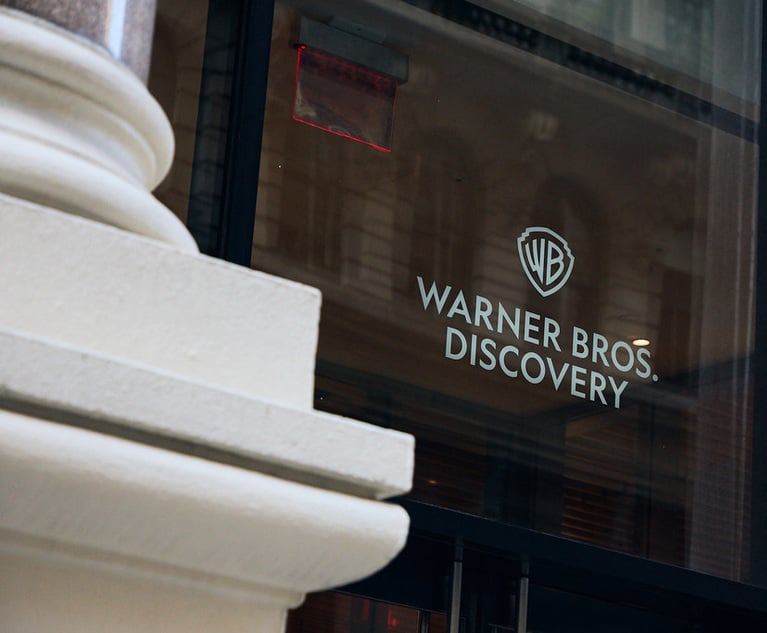Social Networking Sites May Present Difficult Intellectual Property Issues
Appropriate policies will allow companies to use social networks to their advantage.
August 16, 2010 at 08:00 PM
9 minute read
The original version of this story was published on Law.com
 By now, many people are familiar with Facebook and the proposition the social networking site repeatedly poses: “X wants to be friends with you on Facebook . . . confirm or ignore?”
By now, many people are familiar with Facebook and the proposition the social networking site repeatedly poses: “X wants to be friends with you on Facebook . . . confirm or ignore?”
For most companies, there is no ignoring the fact that having a presence on social networking sites can be very productive. Facebook, Twitter, MySpace and others, including “virtual world” websites such as Second Life, offer companies unprecedented access to customers to help build brand awareness, build excitement about new products and forge closer, more lasting bonds with consumers through promotions and interactive communications. In turn, social network users may comment on a company's posted information and declare themselves “fans” of the company or product, quickly reaching other consumers with good publicity. Despite these obvious benefits, like many relationships, your company's friendship with social networking sites and their users can be “complicated.”
Social networking sites present several risks, including trademark infringement and copyright violation issues. For example, your company's valuable trademarks could appear without authorization on a user's profile page or as part of a user name (“name squatting”) on a social networking site. In many instances, unauthorized uses of your company's marks could cause consumer confusion as to source, sponsorship or affiliation. Although the types of intellectual property infringements that occur on social network sites are similar to those that occur on traditional websites, social network infringements can spread rapidly and exponentially, becoming “viral,” and may present an acute crisis for a company and its corporate counsel.
What can be done when an infringement occurs on a social networking site? The leading social networking sites have adopted dispute procedures for intellectual property issues. In most cases, these procedures are the best starting point for corporate counsel faced with intellectual property infringements or other sensitive issues, such as false advertising and defamation. The dispute procedures allow for removal of infringing content and termination of infringing users, at relatively low cost and with little or no interaction between the company and the infringing users.
If the harm caused by the infringement is acute, implicates public health through an issue such as counterfeiting or if the social networking site is unresponsive to counsel's concerns, traditional enforcement methods may be pursued against the social networking site and the infringing user, including cease and desist letters and potentially an infringement action. If the company decides to take action against the social networking site, then theories of direct, contributory and vicarious liability should be considered.
Great care should be taken on several fronts, however. For example, a user who receives a heavy-handed or over-reaching demand letter could pass it along through the social networks, creating negative publicity travelling at “viral” speed. In many instances, it will be advantageous to initially take a soft approach with users and closely consider whether a positive relationship can be developed from the user's possibly well-intentioned, though technically infringing, actions. For example, some companies, when faced with unauthorized uses of their marks by fans on Facebook, have partnered with those fans to help reform the content and to reach the extensive following the fans developed on Facebook.
Moreover, careful consideration must be given to whether defenses such as fair use, parody, criticism, commentary or others are viable before initiating contact with the user or the site. Of course, a traditional cease and desist letter, threatening suit and demanding immediate action, may result in a declaratory judgment action by the recipient(s). To reduce the risk of a declaratory judgment action, the company may want to communicate its concerns and establish a dialogue through a carefully worded letter of inquiry rather than a relatively harsh cease and desist letter.
Importantly, a company can take preventative measures to deter misuse of its intellectual property on social networking sites. For example, a company can create Facebook vanity URLs and Twitter accounts featuring the company's name, new product names and existing product names. A company can also establish an “official” company page on social networking sites. By proactively securing a presence for the company's most valuable marks, a company may reduce intellectual property enforcement expenses, while simultaneously advertising its brands to consumers.
Employees' improper use of social networking sites can also present risks to a company. To prevent and mitigate public relations and liability issues caused by employees' use of social networking sites, companies should adopt social networking policies and train employees on the appropriate use of social networking sites as it relates to the company.
Social networking sites can present difficult enforcement and liability issues, but with appropriate preventative measures, consistent monitoring and carefully designed enforcement priorities and actions, companies can “confirm” social networking sites and their users as friends with few reservations.
Read Christopher Dolan's next column.
 By now, many people are familiar with Facebook and the proposition the social networking site repeatedly poses: “X wants to be friends with you on Facebook . . . confirm or ignore?”
By now, many people are familiar with Facebook and the proposition the social networking site repeatedly poses: “X wants to be friends with you on Facebook . . . confirm or ignore?”
For most companies, there is no ignoring the fact that having a presence on social networking sites can be very productive. Facebook, Twitter, MySpace and others, including “virtual world” websites such as Second Life, offer companies unprecedented access to customers to help build brand awareness, build excitement about new products and forge closer, more lasting bonds with consumers through promotions and interactive communications. In turn, social network users may comment on a company's posted information and declare themselves “fans” of the company or product, quickly reaching other consumers with good publicity. Despite these obvious benefits, like many relationships, your company's friendship with social networking sites and their users can be “complicated.”
Social networking sites present several risks, including trademark infringement and copyright violation issues. For example, your company's valuable trademarks could appear without authorization on a user's profile page or as part of a user name (“name squatting”) on a social networking site. In many instances, unauthorized uses of your company's marks could cause consumer confusion as to source, sponsorship or affiliation. Although the types of intellectual property infringements that occur on social network sites are similar to those that occur on traditional websites, social network infringements can spread rapidly and exponentially, becoming “viral,” and may present an acute crisis for a company and its corporate counsel.
What can be done when an infringement occurs on a social networking site? The leading social networking sites have adopted dispute procedures for intellectual property issues. In most cases, these procedures are the best starting point for corporate counsel faced with intellectual property infringements or other sensitive issues, such as false advertising and defamation. The dispute procedures allow for removal of infringing content and termination of infringing users, at relatively low cost and with little or no interaction between the company and the infringing users.
If the harm caused by the infringement is acute, implicates public health through an issue such as counterfeiting or if the social networking site is unresponsive to counsel's concerns, traditional enforcement methods may be pursued against the social networking site and the infringing user, including cease and desist letters and potentially an infringement action. If the company decides to take action against the social networking site, then theories of direct, contributory and vicarious liability should be considered.
Great care should be taken on several fronts, however. For example, a user who receives a heavy-handed or over-reaching demand letter could pass it along through the social networks, creating negative publicity travelling at “viral” speed. In many instances, it will be advantageous to initially take a soft approach with users and closely consider whether a positive relationship can be developed from the user's possibly well-intentioned, though technically infringing, actions. For example, some companies, when faced with unauthorized uses of their marks by fans on Facebook, have partnered with those fans to help reform the content and to reach the extensive following the fans developed on Facebook.
Moreover, careful consideration must be given to whether defenses such as fair use, parody, criticism, commentary or others are viable before initiating contact with the user or the site. Of course, a traditional cease and desist letter, threatening suit and demanding immediate action, may result in a declaratory judgment action by the recipient(s). To reduce the risk of a declaratory judgment action, the company may want to communicate its concerns and establish a dialogue through a carefully worded letter of inquiry rather than a relatively harsh cease and desist letter.
Importantly, a company can take preventative measures to deter misuse of its intellectual property on social networking sites. For example, a company can create Facebook vanity URLs and Twitter accounts featuring the company's name, new product names and existing product names. A company can also establish an “official” company page on social networking sites. By proactively securing a presence for the company's most valuable marks, a company may reduce intellectual property enforcement expenses, while simultaneously advertising its brands to consumers.
Employees' improper use of social networking sites can also present risks to a company. To prevent and mitigate public relations and liability issues caused by employees' use of social networking sites, companies should adopt social networking policies and train employees on the appropriate use of social networking sites as it relates to the company.
Social networking sites can present difficult enforcement and liability issues, but with appropriate preventative measures, consistent monitoring and carefully designed enforcement priorities and actions, companies can “confirm” social networking sites and their users as friends with few reservations.
Read Christopher Dolan's next column.
This content has been archived. It is available through our partners, LexisNexis® and Bloomberg Law.
To view this content, please continue to their sites.
Not a Lexis Subscriber?
Subscribe Now
Not a Bloomberg Law Subscriber?
Subscribe Now
NOT FOR REPRINT
© 2025 ALM Global, LLC, All Rights Reserved. Request academic re-use from www.copyright.com. All other uses, submit a request to [email protected]. For more information visit Asset & Logo Licensing.
You Might Like
View All


SEC Puts Beat Down on Ex-Wrestling CEO Vince McMahon for Not Reporting Settlements
3 minute readTrending Stories
- 1'It's Not Going to Be Pretty': PayPal, Capital One Face Novel Class Actions Over 'Poaching' Commissions Owed Influencers
- 211th Circuit Rejects Trump's Emergency Request as DOJ Prepares to Release Special Counsel's Final Report
- 3Supreme Court Takes Up Challenge to ACA Task Force
- 4'Tragedy of Unspeakable Proportions:' Could Edison, DWP, Face Lawsuits Over LA Wildfires?
- 5Meta Pulls Plug on DEI Programs
Who Got The Work
Michael G. Bongiorno, Andrew Scott Dulberg and Elizabeth E. Driscoll from Wilmer Cutler Pickering Hale and Dorr have stepped in to represent Symbotic Inc., an A.I.-enabled technology platform that focuses on increasing supply chain efficiency, and other defendants in a pending shareholder derivative lawsuit. The case, filed Oct. 2 in Massachusetts District Court by the Brown Law Firm on behalf of Stephen Austen, accuses certain officers and directors of misleading investors in regard to Symbotic's potential for margin growth by failing to disclose that the company was not equipped to timely deploy its systems or manage expenses through project delays. The case, assigned to U.S. District Judge Nathaniel M. Gorton, is 1:24-cv-12522, Austen v. Cohen et al.
Who Got The Work
Edmund Polubinski and Marie Killmond of Davis Polk & Wardwell have entered appearances for data platform software development company MongoDB and other defendants in a pending shareholder derivative lawsuit. The action, filed Oct. 7 in New York Southern District Court by the Brown Law Firm, accuses the company's directors and/or officers of falsely expressing confidence in the company’s restructuring of its sales incentive plan and downplaying the severity of decreases in its upfront commitments. The case is 1:24-cv-07594, Roy v. Ittycheria et al.
Who Got The Work
Amy O. Bruchs and Kurt F. Ellison of Michael Best & Friedrich have entered appearances for Epic Systems Corp. in a pending employment discrimination lawsuit. The suit was filed Sept. 7 in Wisconsin Western District Court by Levine Eisberner LLC and Siri & Glimstad on behalf of a project manager who claims that he was wrongfully terminated after applying for a religious exemption to the defendant's COVID-19 vaccine mandate. The case, assigned to U.S. Magistrate Judge Anita Marie Boor, is 3:24-cv-00630, Secker, Nathan v. Epic Systems Corporation.
Who Got The Work
David X. Sullivan, Thomas J. Finn and Gregory A. Hall from McCarter & English have entered appearances for Sunrun Installation Services in a pending civil rights lawsuit. The complaint was filed Sept. 4 in Connecticut District Court by attorney Robert M. Berke on behalf of former employee George Edward Steins, who was arrested and charged with employing an unregistered home improvement salesperson. The complaint alleges that had Sunrun informed the Connecticut Department of Consumer Protection that the plaintiff's employment had ended in 2017 and that he no longer held Sunrun's home improvement contractor license, he would not have been hit with charges, which were dismissed in May 2024. The case, assigned to U.S. District Judge Jeffrey A. Meyer, is 3:24-cv-01423, Steins v. Sunrun, Inc. et al.
Who Got The Work
Greenberg Traurig shareholder Joshua L. Raskin has entered an appearance for boohoo.com UK Ltd. in a pending patent infringement lawsuit. The suit, filed Sept. 3 in Texas Eastern District Court by Rozier Hardt McDonough on behalf of Alto Dynamics, asserts five patents related to an online shopping platform. The case, assigned to U.S. District Judge Rodney Gilstrap, is 2:24-cv-00719, Alto Dynamics, LLC v. boohoo.com UK Limited.
Featured Firms
Law Offices of Gary Martin Hays & Associates, P.C.
(470) 294-1674
Law Offices of Mark E. Salomone
(857) 444-6468
Smith & Hassler
(713) 739-1250







